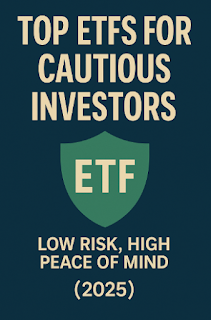 |
| Best ETF |
In 2025, the search for stable, income-generating investments is more important than ever especially for conservative investors. After a volatile few years marked by inflation shocks, rapid rate hikes, tech bubbles, and geopolitical uncertainty, many investors are now more focused on preserving capital and generating reliable returns than chasing the next big growth story. Exchange-Traded Funds (ETFs) offer one of the most efficient ways to achieve this balance, combining diversification, liquidity, and cost-efficiency in a single package. But not all ETFs are created equal, and for conservative investors, the criteria are different. It’s not about shooting the lights out it’s about consistency, downside protection, and real yield. With that in mind, several ETF categories stand out in 2025 as strong candidates for low-risk, long-term portfolios.
Dividend-focused ETFs are leading the charge, and for good reason. Funds like Schwab U.S. Dividend Equity ETF (SCHD) and Vanguard High Dividend Yield ETF (VYM) are top picks among conservative investors. These ETFs focus on established companies with a track record of paying and growing dividends. SCHD, in particular, screens for quality companies with strong balance sheets and high return on equity while maintaining a relatively low expense ratio of 0.06%. In 2025, with bond yields flattening and equity markets pricing in slower growth, dividend ETFs are offering yields between 3.5% and 4.5% a solid return in a risk-managed equity wrapper. More importantly, they tend to be less volatile than growth-focused ETFs, making them ideal for investors who want equity exposure without tech-heavy swings.
Another core category is broad-market low-volatility ETFs, such as Invesco S&P 500 Low Volatility ETF (SPLV). This ETF invests in the 100 least volatile stocks in the S&P 500, effectively filtering out high-beta names in favor of stable performers. In years like 2022 or 2023, SPLV significantly outperformed the broader index during drawdowns. In 2025, with markets moving sideways and volatility still lurking under the surface, low-volatility strategies are back in style. They don’t promise huge gains but that’s exactly the point. They’re designed to help portfolios grind upward, not rocket skyward.
For fixed income exposure, conservative investors are leaning heavily into short-duration bond ETFs, particularly U.S. Treasury-focused funds. ETFs like iShares Short Treasury Bond ETF (SHV) and SPDR Bloomberg 1-3 Month T-Bill ETF (BIL) are offering yields near 5% in early 2025, with extremely low duration risk. For those looking to go slightly longer out on the curve, Vanguard Short-Term Bond ETF (BSV) or iShares 1-5 Year Investment Grade Corporate Bond ETF (IGSB) offer solid alternatives with slightly higher yields and minimal credit risk. These ETFs are ideal for investors who want yield without the volatility that comes from long-duration exposure, which remains risky in a still-evolving rate environment.
TIPS (Treasury Inflation-Protected Securities) ETFs have also regained relevance in 2025. While inflation has cooled compared to 2022–2023 levels, it hasn’t disappeared and the Fed remains cautious. For investors who want to protect purchasing power without giving up safety, funds like iShares TIPS Bond ETF (TIP) or Schwab U.S. TIPS ETF (SCHP) offer direct inflation protection backed by the U.S. government. In a world where unexpected inflation spikes can still shake markets, TIPS provide peace of mind and better real returns than cash when inflation ticks higher.
Another ETF type gaining traction among conservative investors is the multi-asset or balanced ETF. Funds like iShares Core Conservative Allocation ETF (AOK) or Vanguard LifeStrategy Income Fund (VASIX) combine exposure to equities, bonds, and cash-equivalents in a single fund. These “set-it-and-forget-it” solutions are built for risk-managed total return. In 2025, where timing the market is proving difficult and economic signals are mixed, multi-asset ETFs offer automatic diversification without constant rebalancing.
Costs matter more than ever, especially in a low-return environment. The good news for conservative investors is that many of the ETFs mentioned above carry expense ratios below 0.10%, meaning more of your money is working for you rather than going to fund managers. This is particularly important for long-term investors who plan to hold these positions for years, if not decades.
And finally, don’t underestimate liquidity and transparency. One of the underrated benefits of ETFs over mutual funds is intraday liquidity. If markets turn quickly, conservative investors may want the ability to adjust their exposure without waiting for end-of-day NAV pricing. ETFs allow for that flexibility, even in sleepy allocations. Coupled with transparent holdings and regular rebalancing rules, ETFs provide the kind of predictability that aligns perfectly with a conservative investor’s mindset.
In short, the best ETFs for conservative investors in 2025 aren’t flashy and that’s the point. They prioritize capital preservation, deliver consistent income, and hold up in rough markets. Whether through dividend strength, bond stability, or diversified exposure, these funds allow investors to stay in the game without playing with fire. For those more interested in sleeping well at night than checking their portfolio every hour, these ETFs offer a sound foundation especially in a market where uncertainty still outweighs optimism.









0 Comments